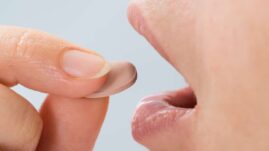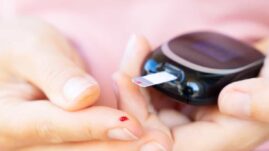Nearly 1 in 3 American adults have prediabetes—and many people do not even realize that they have the condition!
The good news is that prediabetes can be reversed. While in many cases, type 2 diabetes can be delayed and even prevented entirely.
So that begs the question: What is the most effective way to reverse prediabetes?
This article will explore what prediabetes is and the best ways to reverse it.

Table of Contents
- What is prediabetes?
- What are the symptoms of prediabetes?
- How do you manage prediabetes?
- Is prediabetes reversible?
- What is the most effective way to reverse prediabetes?
- Other ways to reverse prediabetes
- How long does it take to reverse prediabetes?
- Does prediabetes always develop into type 2 diabetes?
- Do people with prediabetes take insulin?
- If you reverse prediabetes, can it come back?
What is prediabetes?
Prediabetes is a condition where the blood sugar levels are more elevated than normal, but not so elevated that it warrants a type 2 diabetes diagnosis.
Prediabetes usually develops after several years of insulin resistance. The following are typical blood sugar levels of someone who has prediabetes:
- Fasting blood sugar between 100-125 mg/dL
- Blood sugar 2 hours after a meal between 140-199 mg/dL
- An HbA1c test between 5.7-6.4%
Without intervention, around 70% of people with prediabetes go on to develop type 2 diabetes within a few years.
What are the symptoms of prediabetes?
Prediabetes can be hard to diagnose based on symptoms alone because many people experience no symptoms at all.
However, some people may experience the following:
- Excessive thirst
- Frequent urination
- Excessive hunger
- Weight loss
- Fatigue and lethargy
- Blurry vision/changes in vision
If you are experiencing these symptoms and you’re overweight, obese, and over 35 years old, the United States Preventive Services Task Force (USPSTF) recommends that you ask your doctor for a fasting blood sugar test to see if you may have prediabetes.
If you’re experiencing these symptoms and don’t have any risk factors for diabetes, it does not hurt to call your doctor to see if they’d recommend a fasting blood sugar test anyway.
Many cases of type 1 and type 2 diabetes are diagnosed in people who are not obese or overweight and are younger than 35 years old.
How do you manage prediabetes?
Prediabetes is primarily managed by diet and exercise. Talk with your doctor about dietary changes you can easily make and ways to increase your daily physical activity.
If you are overweight, the American Diabetes Association recommends losing at least 5% of your body weight to help manage insulin resistance and prediabetes.
If you have cardiovascular risk factors in addition to prediabetes, your doctor may also recommend medication to help manage high blood pressure and high cholesterol levels.
Is prediabetes reversible?
Yes! The good news is that prediabetes is reversible in most cases. You just need to take the necessary steps to reverse it within your first few years of diagnosis.
The window of opportunity to delay or entirely prevent type 2 diabetes is between two to six years after being diagnosed with prediabetes. After that time, most people develop type 2 diabetes, which is not always reversible.
Reversing prediabetes depends upon losing excess weight and increasing your physical activity levels. This depends on how long it takes you to lose between 5-7% of your total body weight.
What is the most effective way to reverse prediabetes?
Medical experts know that weight loss, a healthy prediabetes diet, and increased daily exercise all play a role in helping patients reverse their prediabetes diagnosis. But how?
The Centers for Disease Control and Prevention (CDC) recommends the National Diabetes Prevention Program (NDPP) as the best way to help reverse prediabetes and prevent type 2 diabetes.
There are CDC-certified NDPP programs in every state, and most health insurance plans will cover almost all of the program’s costs.
The efficacy of the NDPP was compared against metformin in trials.
Researchers found that positive changes in diet and physical activity significantly reduced the chances of a person with prediabetes developing type 2 diabetes.
The NDPP group modified their diet and exercise habits. They aimed for 150 minutes of activity per week and a diet of fewer calories and less fat to lose 7% of their total body weight.
The metformin group took 850 mg of metformin twice per day. The third group received placebo pills.
The NDPP group reduced their risk of developing type 2 diabetes by 58%, which was true across all ethnic groups and genders. For people 60 and older, their risk was slashed by 71%.
Participants in the metformin group cut their risk of developing diabetes by 31%, and this was seen in both men and women but was less effective in people 45 years and older.
About 5% of people in the NDPP group developed diabetes each year, compared to 7.8% in the metformin group.
11% of people in the placebo group developed diabetes each year.
This study was revolutionary in the diabetes prevention world and proves that long-term diet and exercise are even more effective at preventing type 2 diabetes than taking metformin.
“I think the biggest changes in my diet have been reducing the amount of fast food and sugary drinks I have regularly. I’ve also reduced my dinner portions but have mostly reduced the amount of rice, noodles, and pasta I have several hours before bedtime. I also work out at least five times a week.”
Venus Jones (read Venus’ story of reversing prediabetes)
Other ways to reverse prediabetes
Here are some other strategies you can take to lose weight and reverse prediabetes:
- Cook at home more
- Avoid fried and greasy foods
- Increase your protein intake at all meals
- Eat smaller portions
- Eat whole, unprocessed foods
- Drink only water and no sugar-sweetened beverages
- Cut out processed and refined carbohydrates
- Get adequate sleep (between 7-9 hours per night for most people)
- Take all medications as prescribed
- Manage stress with deep breathing, meditation, and yoga
- Limit alcohol
How long does it take to reverse prediabetes?
This will all depend on the person. However, if you have prediabetes, do not expect to reverse it immediately.
Safe, healthy, sustainable weight loss is best and will be most effective at delaying or completely preventing the development of type 2 diabetes.
It may take 3–5 months, or even a year, to lose the weight necessary to reverse prediabetes.
You can read more about how long it may take to reverse prediabetes here.
Does prediabetes always develop into type 2 diabetes?
The good news is that if you are diagnosed with prediabetes, this does not mean you’ll go on to develop type 2 diabetes.
Talk with your doctor about developing an exercise and diet plan that will work for you, your health goals, and your lifestyle. Better yet, join an NDPP program near you for the best results!
However, if you wait longer than several years after your diagnosis to make health changes, the window of opportunity does close.
Do people with prediabetes take insulin?
This varies by the patient, but most people with prediabetes do not need insulin. Prediabetes is largely managed by diet and exercise alone.
If you’re at high risk for other health issues, such as heart disease and hypertension, you may be prescribed additional medications, such as metformin, Ozempic, or Victoza.
If you reverse prediabetes, can it come back?
You are at risk of developing prediabetes again if you stop exercising and maintaining a healthy diet.
This is why sustainable weight loss is recommended for long-term success.
Talk with your doctor if you have questions or concerns about sustainable, long-term weight loss and weight maintenance.



